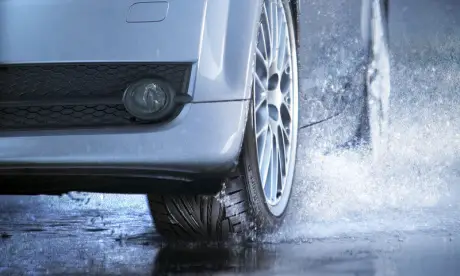
It can be quite a challenge to drive safely on a wet road or during the rain, and when the road doesn't drain sufficiently or the heavy rain happens to form puddles, then it can indeed become quite dangerous for the vehicle, especially when the tires are not ready for such conditions.
If you have skidded while driving a vehicle on a wet road for a minimal time or even longer, and even if you haven't experienced a complete loss of control, then you have faced hydroplaning.
You must be wondering what causes hydroplaning and how to prevent it. For that, you need to understand this effect and use a few essential tips so that you can avoid it when it occurs.
What is Hydroplaning?
Hydroplaning is a term that refers to the sliding or skidding of the vehicle tires across a wet surface. Such an incident occurs when a car tire happens to encounter more water than it is capable of scattering.
The water pressure on the front of the tire pushes this water under the tire, so the tire gets separated from the road surface by a thin water film, thus losing traction. This can result in loss of braking, steering, and power control.
Grooves on the rubber tires are specially designed to channel this water from under the tire. Therefore, it can create high friction on the road surface and minimize or even prevent the instances of hydroplaning that may occur.
What causes Hydroplaning?
Although hydroplaning can occur on any of the wet surfaces, the most dangerous ones are the first ten minutes of light rain. When this light rain gets mixed with the oil residue on the road, then it can create slippery conditions causing the vehicles to hydroplane. It is worth noting that this can be quite a deadly combination for the car and even the surrounding vehicles.
Poor weather conditions increase the chances of motor vehicle accidents, especially when it is raining or snowing. You should recognize that it is not the blinding snow or the pounding rain that can be dangerous, but it is the slick conditions that the majority of drivers may not be prepared for.
How to prevent Hydroplaning?
- Avoid puddles of any size
It doesn't need a lot of water to hydroplane, especially for those unsure about what causes hydroplaning and how to prevent it? Therefore, you need to stay out of the puddles if possible. If it keeps raining for a longer time, the puddle may get more profound, and then you are likely to hydroplane.
- Make sure that the tires have sufficient tread depth
If you have worn tires, it means that they have less tread depth and may not have deep channels that could move the water away. It is worth noting that this can cause the tires to ride efficiently on the water, and if you are on top of this water, you certainly don’t have traction.
- Reduce the speed
The most dangerous time for driving is the one when it just starts raining; therefore, it is always a good idea for you to slow down. Rain can mix with rubber and oil on the road, thus creating a slicker surface, and this can cause hydroplaning.
Final Thoughts
The majority of hydroplaning situations can last for just a few seconds, but it is essential for you to know all the ways to deal with them. If you think about what causes hydroplaning and how to prevent it, the best defense for you is to make sure that you have good tires and maintain them properly.
The tread depth and air pressure should be checked at regular intervals, and it is always recommended to rotate the tires during each oil change.
Same articles

Understanding Vehicle Inspection and Verification Services: Why They Matter for Every Driver
GuidesVehicle inspection and verification services are an essential but often overlooked part of keeping roads safe and cars legally compliant. Most people only think about inspections when it’s...
KLIFEX Brand Overview: High-Quality Automotive Repair Kits for Affordable Repairs
GuidesThe automotive aftermarket has long needed solutions that combine reliability, durability, and affordability. Many car enthusiasts and services are looking for a way...
Fast, Reliable Vehicle Emissions & Inspection Services Made Simple
GuidesFast, reliable emissions and inspection services are essential for keeping vehicles road-ready, compliant with environmental regulations, and safe for daily driving. If you’re looking for quick...

